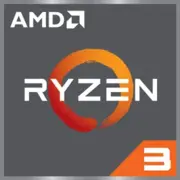AMD Ryzen 3 PRO 4355GE

AMD Ryzen 3 PRO 4355GE: A Complete Guide to the Budget Processor with Integrated Graphics
March 2025
Key Features: Architecture, Process Technology, Performance
The AMD Ryzen 3 PRO 4355GE processor is an energy-efficient solution for office tasks, home PCs, and compact systems. It is built on the Zen 2 architecture, which, despite its age, remains relevant due to its optimized balance between performance and power consumption.
- Process Technology: The 7nm TSMC FinFET technology ensures low thermal output (TDP of 35W) and high efficiency.
- Cores and Threads: 4 cores and 8 threads are sufficient for multitasking but not suitable for heavy computations.
- Cache Memory: 4MB of L3 cache is modest, which may limit speed in resource-intensive applications.
- Graphics: The integrated Radeon Vega 6 (with 6 GPU cores, clock speeds up to 1.5 GHz) handles HD video and light gaming adequately.
- Key Features: Support for PRO technologies (data protection, remote management), Precision Boost 2 for automatic overclocking.
In practice, the processor demonstrates stable performance in office suites (Microsoft Office, browsers with 10+ tabs) and video conferencing applications. In Cinebench R23 tests, it scores around 5800 points in multi-threaded mode — a level comparable to the Intel Core i3-10100 but with better energy efficiency.
Compatible Motherboards: Sockets and Chipsets
The Ryzen 3 PRO 4355GE uses the AM4 socket, which is supported by most motherboards with the following chipsets:
- B550 — an optimal choice: PCIe 4.0, memory overclocking, stability. Example: ASUS TUF Gaming B550M-Plus ($120).
- A520 — a budget option without overclocking: suitable for basic builds (e.g., Gigabyte A520M DS3H, $75).
- B450/X470 — require a BIOS update. Suitable for upgrading older systems.
Important: For PRO processors, motherboards that support AMD PRO technologies (e.g., ASUS ProArt B550-Creator) are recommended. This ensures functionality such as Secured Core PC.
Supported Memory: DDR4 and Optimization
The processor works with DDR4 memory (up to 3200 MHz). Recommendations:
- Mode: Always use a dual-channel configuration (2x8 GB instead of 1x16 GB) to increase bandwidth.
- Frequency: 3200 MHz is optimal. Overclocking to 3600 MHz is possible but not always stable.
- Volume: 16 GB is sufficient for most tasks. For multimedia (photo/video editing), 32 GB is better.
Example kit: Kingston Fury Beast DDR4-3200 16 GB (2x8 GB) — $50.
Power Supplies: Power Calculation
With a TDP of 35W, the Ryzen 3 PRO 4355GE does not require a powerful power supply unit (PSU). Recommendations:
- Without discrete graphics: A PSU of 300–400W is sufficient (e.g., be quiet! System Power 10 400W, $45).
- With a graphics card: For an RTX 3050 or RX 6600, choose a PSU of 500–550W (Corsair CX550, $65).
Tip: Don’t skimp on the PSU. 80 Plus Bronze or higher certifications ensure stability and longevity.
Pros and Cons
Advantages:
- Energy efficiency: Ideal for compact PCs and systems with passive cooling.
- Integrated graphics: Runs CS:GO on medium settings (60+ FPS at 1080p).
- Reliability: PRO features protect against viruses and hardware failures.
Disadvantages:
- Limited performance: 4 cores can be a bottleneck for rendering or streaming.
- Outdated architecture: Zen 2 lags behind Zen 3/4 in IPC (Instructions Per Cycle).
- No support for DDR5 and PCIe 5.0.
Use Cases
1. Office Tasks: Working with documents, browsers, Zoom.
2. Multimedia: Watching 4K videos, editing in DaVinci Resolve (projects up to 1080p).
3. Light Gaming: Dota 2, Minecraft, GTA V (on low settings).
4. Home Server: Low power consumption allows the processor to be used in a NAS.
Real-world experience: Users note that a system with the Ryzen 3 PRO 4355GE consumes only 50-70W while idle, making it economical for 24/7 operation.
Comparison with Competitors
- Intel Core i3-13100: 4 cores/8 threads, UHD Graphics 730. Better at single-threaded tasks (+15%), but more expensive ($140) and lacks PRO features.
- Ryzen 5 5600G: 6 cores/12 threads, Vega 7. 30% more powerful, but TDP of 65W and price of $170.
- Apple M1 (in a mini PC): More energy-efficient, but limited compatibility with Windows.
Conclusion: The Ryzen 3 PRO 4355GE is a budget-friendly option if PRO features and low energy consumption are needed.
Practical Assembly Tips
1. Cooler: The stock cooler is sufficient, but for quiet operation, consider the DeepCool GAMMAXX 400 V2 ($25).
2. Case: Choose compact models (Fractal Design Core 500) for HTPCs.
3. BIOS: Update the motherboard BIOS via USB Flashback before installation.
4. Drivers: Install Adrenalin Edition for optimized performance of the Vega 6.
Mistake to Avoid: Using single-channel memory (e.g., 1x16 GB) can reduce performance by 10-15%.
Final Conclusion: Who is the Ryzen 3 PRO 4355GE Suitable For?
This processor is worth choosing if:
- Budget is limited: Priced around $130 (new), making it accessible.
- Stability is needed: PRO features will protect corporate PCs.
- Low noise is a priority: Passive cooling is feasible in small cases.
- Top-tier graphics are not required: AAA gaming will need a discrete graphics card.
Alternative: If the budget allows, the Ryzen 5 8600G (Zen 4, RDNA 3) offers twice the performance for $220, but for basic tasks, this is excessive.
The Ryzen 3 PRO 4355GE is a successful compromise for those who value reliability and energy savings without overspending.
Basic
CPU Specifications
Memory Specifications
GPU Specifications
Miscellaneous
Benchmarks
Compared to Other CPU
Share in social media
Or Link To Us
<a href="https://cputronic.com/en/cpu/amd-ryzen-3-pro-4355ge" target="_blank">AMD Ryzen 3 PRO 4355GE</a>